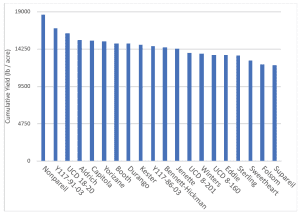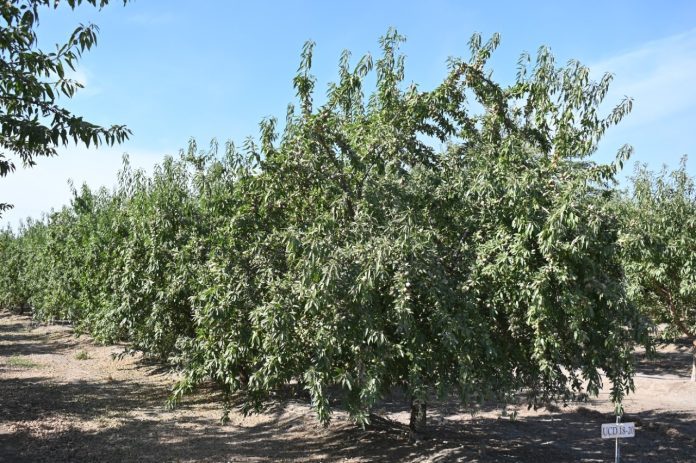
The king of the California almond industry is still Nonpareil, a variety introduced way back in 1879 by A.T. Hatch. Growers like its high value, relatively consistent high yields, low disease susceptibility, early harvest and general ease of farming. Marketers like it because of its versatility, soft shell, large size, blonde color and low-percent defects like doubles or creases. Like every variety, Nonpareil has its flaws. Its poor shell seal makes it susceptible to navel orangeworm, and too much water and nitrogen fertilizer can lead to excessive hull rot. The biggest Achilles heel of Nonpareil is it is not self-fertile, which means it must be planted with one or more pollinizer varieties. This requires two strong beehives per acre and decent weather in the month of February to allow for maximum pollen transfer and fertilization to take place. Even after 140 years, almond growers struggle to find the perfect pollinizer varieties to plant with their Nonpareil.
With funding provided by the Almond Board of California, through assessments paid by almond growers, the University of California has conducted regional field trials in the major almond growing areas of the Central Valley for over 50 years. In each of these trials, up to 30 commercial and experimental varieties are monitored side by side in commercial settings for yield, kernel quality and horticultural characteristics. The results are available for all almond growers to see so they can make informed decisions when choosing which varieties to plant. Previous trials have documented the performance of the top 14 out of 15 varieties most planted in California today. Perhaps more importantly, many poor performing dogs were exposed before growers made a 25-year commitment to a bad variety!
Although we are still searching for that perfect Nonpareil pollinizer, today the emphasis is on self-fertile varieties, which require fewer bees, are cheaper and easier to farm, reduce harvest dust by at least 50% compared to Nonpareil orchards and should have more consistent yields in years with poor bloom weather (2023 comes to mind.) Of course, we also want few insect or disease problems, good yields and high-value kernels, preferably that mature outside of the Nonpareil/Independence harvest window.
In 2014, we planted a third generation of regional almond variety trials. In these trials, we are evaluating 29 commercial and experimental varieties produced from UC Davis, USDA and commercial California nurseries. These varieties are being tested side by side in replicated field trials planted in Madera, Stanislaus and Butte counties. In Madera County, trees are on Hansen 536 rootstock and planted at a 12’ x 21’ spacing (173 trees per acre). In Stanislaus County, trees are on Nemaguard and planted at 16’ x 21’ (130 trees per acre), and in Butte County, trees are on Krymsk 86 and planted 18’ x 22’ (110 trees per acre). Test varieties are planted 50:50 with Nonpareil in alternate rows. In these current regional trials, 12 of the tested varieties are self-fertile.
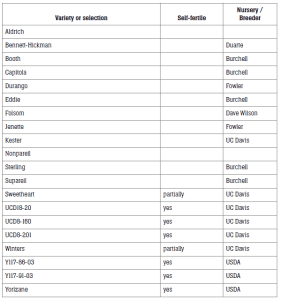
2022 was the ninth leaf of these trials, and a few varieties are rising to the top while many have fallen out the bottom. We have eliminated nine of the 29 varieties (Table 1), mostly due to poor yields, poor nut quality and/or difficulty shaking. Table 2 shows the 2022 yield of the remaining varieties, the average canopy size expressed as the amount of sunlight captured (i.e., photosynthetically active radiation or PAR) and the yield per canopy size. A PAR of 65% means the trees filled 65% of their orchard space. The higher the PAR value, the larger the canopy. Varieties with high yield per PAR are the most efficient and may be the highest yielding if all varieties were at the same canopy cover. A yield of 45 pounds per PAR would be considered excellent, with a theoretical yield of 4500 pounds per acre at 100% canopy cover. For instance, the variety Yorizane is a small tree with an average canopy cover of only 56.3% in these trials. However, the yield per PAR of 47.9 in 2022 indicated the yield potential was very high, and the actual yield in these trials would have been much higher if the trees were planted more closely or put on a more vigorous rootstock.
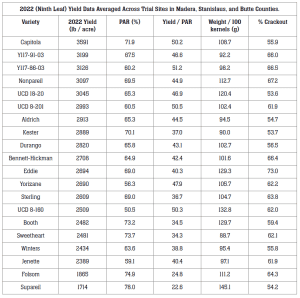
The Most Yield Efficient Varieties in 2022:
Y117-86-03. This is an experimental selection from the USDA breeding program and is self-fertile. It is yielding particularly well in the Butte County trial. Y117-86-03 reaches full bloom about three days after Nonpareil and harvests about 12 days after Nonpareil. The kernels are attractive, light in color, but smaller than Nonpareil. This variety was a little difficult to shake in the early years but appears to be better now. The release date of this experimental variety is pending a decision by USDA.
UCD 8-201. This is an experimental selection from the UC Davis breeding program and is also self-fertile. It is a compact, grower-friendly tree suitable for higher-density plantings. The kernel quality is very good, but unfortunately has a high percentage of doubles and can suffer from excessive hull rot. This variety may not be released due to its high-percent double kernels (29.3% in 2022).
UCD 8-160. This self-fertile, experimental selection from the UC Davis breeding program has a very small, weeping tree structure and typically has the highest yield efficiency in the trials. Because of the small tree size, it would need to be planted in a high-density system and/or on a vigorous rootstock. Bloom time is similar to Nonpareil and harvests more than three weeks later than Nonpareil. This variety also suffers from hull rot and can have higher-than-average percent doubles and creases.
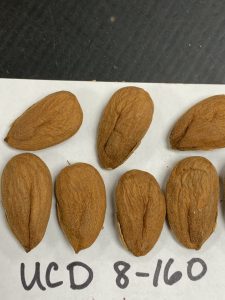
Capitola. Discovered as a seedling tree in the Waterford area of Stanislaus County, this commercial variety is available from Burchell Nursery. Capitola is not self-fertile and would be considered a pollinizer for Nonpareil. Capitola was the variety with the highest average yield in the Madera and Stanislaus sites in 2022. Capitola blooms slightly ahead of Nonpareil and harvests about 8-10 days after Nonpareil. It shakes well in these trials and has had lower-than-average kernel defects, including very-low-percent doubles and low navel orangeworm. The kernel is generally rated as a California type. Capitola was severely affected by bacterial blast in 2019.
Yorizane. This self-fertile variety has recently been released from the USDA breeding program and is available from all participating nurseries. The kernel is light in color and is of excellent quality, although a little smaller than Nonpareil. Although there was some staining of the kernel skin in 2022, defects have historically been very low in these trials, including low doubles and NOW. It is a small tree suitable for higher-density planting and could use a boost from a vigorous peach/almond hybrid rootstock. Bloom time is similar to Nonpareil and harvests a few days before Nonpareil. Yorizane was moderately affected by bacterial blast in 2019.
UCD 18-20. This self-fertile UC Davis experimental selection has been one of the most consistent producers in these regional trials. The kernel has been rated as a Monterey or California type but can have higher-than-average doubles in some years. UCD 18-20 is very easy to shake and is one of the last to harvest in these trials, averaging about a month after Nonpareil. Disease incidence has been very low in this variety, including no hull rot and no bacterial blast in 2019.
Y117-91-03. This self-fertile USDA selection has the highest cumulative yield of all experimental varieties. It blooms a few days before Nonpareil and harvests about one week before Nonpareil. The tree is vigorous, with a nice, upright, grower-friendly structure and shakes well. The kernel is light in color and of excellent quality with no major defects, although smaller than Nonpareil. The unique “butterfly” hullsplit lends to a short hullsplit period, which reduces risk of hull rot and NOW. This exciting new variety is completing its final year of virus cleanup and should be released to all nurseries next year.
With funding provided by the Almond Board of California, UCCE has planted a new round of regional variety trials in Kern, Stanislaus and Butte counties this year, with 25 more experimental varieties from public and private breeding programs in California, Spain and Australia. All but two of these varieties are self-fertile, reflecting the direction of the California almond industry. Unfortunately, it takes many years to fully evaluate a new variety, so the results of these newly planted trials won’t be understood for several more years. However, it is worth the wait to avoid 25 years of regret!
For more information about these trials, watch for announcements of upcoming field days or contact UCCE Farm Advisors Roger Duncan (raduncan@ucanr.edu), Phoebe Gordon (pegordon@ucanr.edu) or Luke Milliron (lkmilliron@ucanr.edu).
